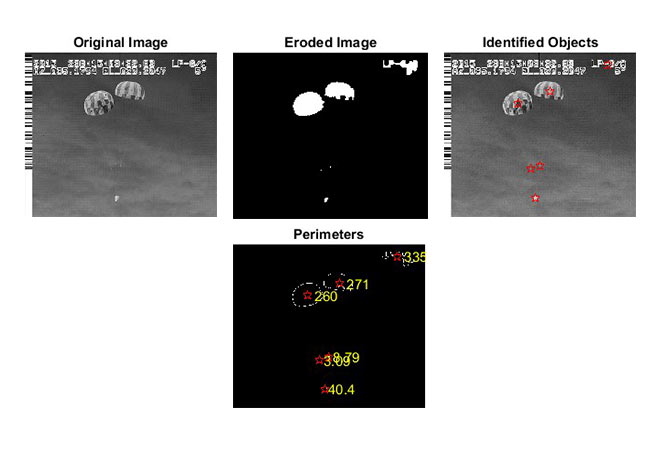Assessing Dynamics of Multi-Body Aerial Systems - Aerodynamic Decelerator Systems Laboratory
Assessing Dynamics of Multi-Body Aerial Systems
As the quality of modern video-capture systems continues to improve, the role that optical systems play in data collection at test ranges is becoming increasingly important as well. It turns out that the same algorithm developed for the “sense” part of an onboard collision-avoidance capability maybe successfully applied by the ground kineto-tracking mounts at the test ranges for aiding in passive characterization of aerial platform dynamics. Application of techniques of image processing and computer vision results in a significant increase of the rate at which valuable information from video can be analyzed versus costly conventional techniques that require laborious and often tedious human operation.
As an example, Fig.G depicts an analysis of a two-body aerial platform, parafoil-based aerial delivery system. The data extracted from flight video is then used to recreate trajectories and estimate the attitude history of both the canopy and payload (it should be noted that this is a very difficult problem to address otherwise – no bulky sensors can be mounted onto the dedicated surfaces of a flexible parafoil canopy). Automated results can not only be delivered to the user within minutes, but are able to measure certain quantities with precision beyond what is capable in some manual data-reduction methods.

Figure G. Automated analysis of parafoil canopy and payload relative dynamics
Figure H presents another example where the developed algorithms allow estimating a relative motion of a three-body system – NASA’s Mars probe Orion under two parachutes.

Figure H. Two-parachute system dynamics analysis.
Downloads
You are welcome to download some of the video clips that are being used within the Computer Vision Analysis of Test Items Dynamics research effort. The INS/GPS data corresponding to these videos are also available per request.

